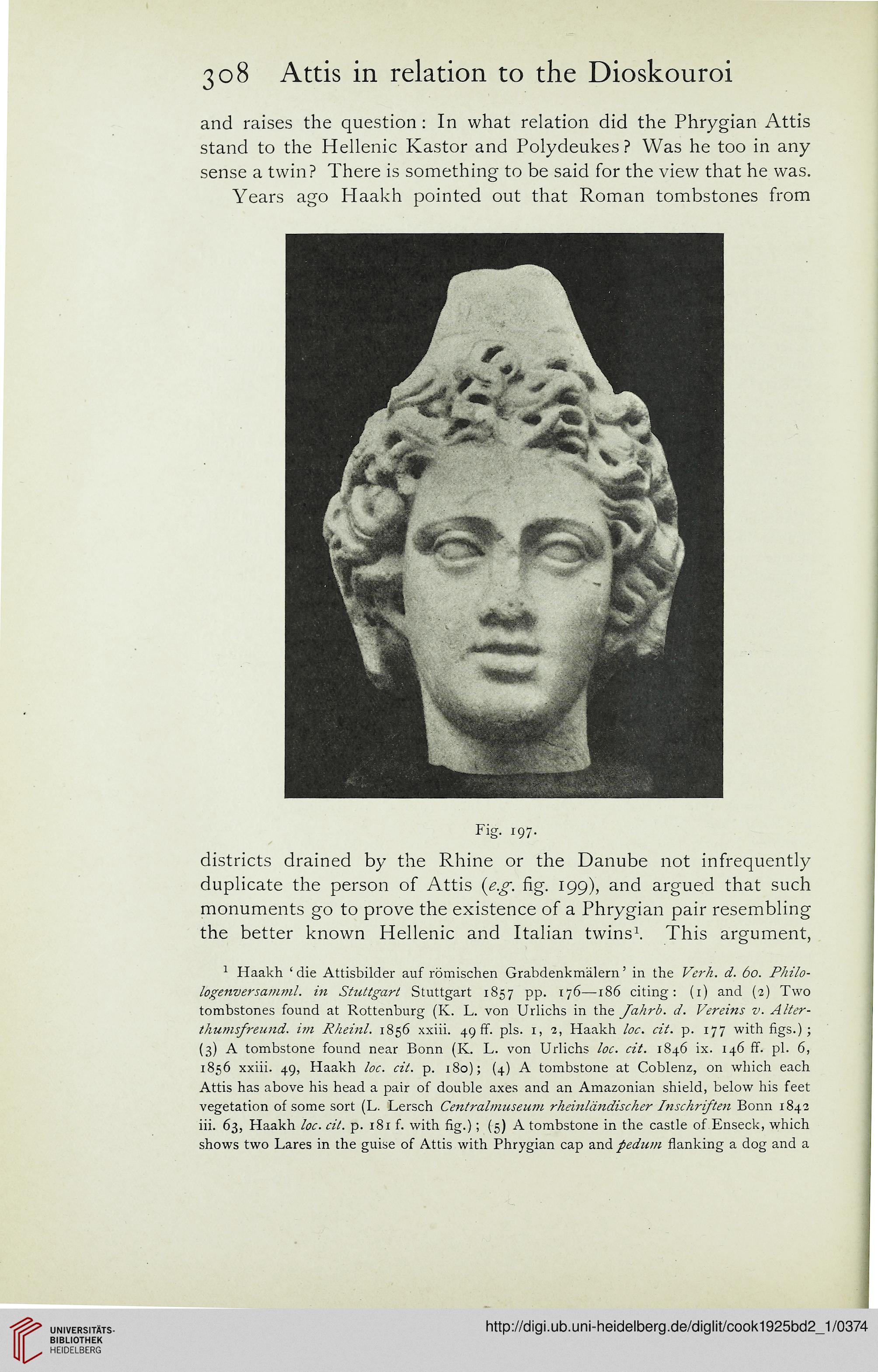308 Attis in relation to the Dioskouroi
and raises the question : In what relation did the Phrygian Attis
stand to the Hellenic Kastor and Polydeukes ? Was he too in any
sense a twin? There is something to be said for the view that he was.
Years ago Haakh pointed out that Roman tombstones from
Fig. 197.
districts drained by the Rhine or the Danube not infrequently
duplicate the person of Attis {e.g. fig. 199), and argued that such
monuments go to prove the existence of a Phrygian pair resembling
the better known Hellenic and Italian twins1. This argument,
1 Haakh 'die Attisbilder auf romischen Grabdenkm'alern' in the Verh. d. 60. Philo-
logenversamml. in Stuttgart Stuttgart 1857 pp. 176—186 citing: (1) and (2) Two
tombstones found at Rottenburg (K. L. von Urlichs in the Jahrb. d. Vereins v. Alter-
thumsfreund. im Rheinl. 1856 xxiii. 49 ff. pis. 1, 2, Haakh loc. at. p. 177 with figs.);
(3) A tombstone found near Bonn (K. L. von Urlichs loc. cit. 1846 ix. 146 ff. pi. 6,
1856 xxiii. 49, Haakh loc. cit. p. 180); (4) A tombstone at Coblenz, on which each
Attis has above his head a pair of double axes and an Amazonian shield, below his feet
vegetation of some sort (L. Lersch Centralmuseum rheinlandischer Inschriften Bonn 1842
iii. 63, Haakh loc. cit. p. 181 f. with fig.); (5) A tombstone in the castle of Enseck, which
shows two Lares in the guise of Attis with Phrygian cap and pedum flanking a dog and a
and raises the question : In what relation did the Phrygian Attis
stand to the Hellenic Kastor and Polydeukes ? Was he too in any
sense a twin? There is something to be said for the view that he was.
Years ago Haakh pointed out that Roman tombstones from
Fig. 197.
districts drained by the Rhine or the Danube not infrequently
duplicate the person of Attis {e.g. fig. 199), and argued that such
monuments go to prove the existence of a Phrygian pair resembling
the better known Hellenic and Italian twins1. This argument,
1 Haakh 'die Attisbilder auf romischen Grabdenkm'alern' in the Verh. d. 60. Philo-
logenversamml. in Stuttgart Stuttgart 1857 pp. 176—186 citing: (1) and (2) Two
tombstones found at Rottenburg (K. L. von Urlichs in the Jahrb. d. Vereins v. Alter-
thumsfreund. im Rheinl. 1856 xxiii. 49 ff. pis. 1, 2, Haakh loc. at. p. 177 with figs.);
(3) A tombstone found near Bonn (K. L. von Urlichs loc. cit. 1846 ix. 146 ff. pi. 6,
1856 xxiii. 49, Haakh loc. cit. p. 180); (4) A tombstone at Coblenz, on which each
Attis has above his head a pair of double axes and an Amazonian shield, below his feet
vegetation of some sort (L. Lersch Centralmuseum rheinlandischer Inschriften Bonn 1842
iii. 63, Haakh loc. cit. p. 181 f. with fig.); (5) A tombstone in the castle of Enseck, which
shows two Lares in the guise of Attis with Phrygian cap and pedum flanking a dog and a




